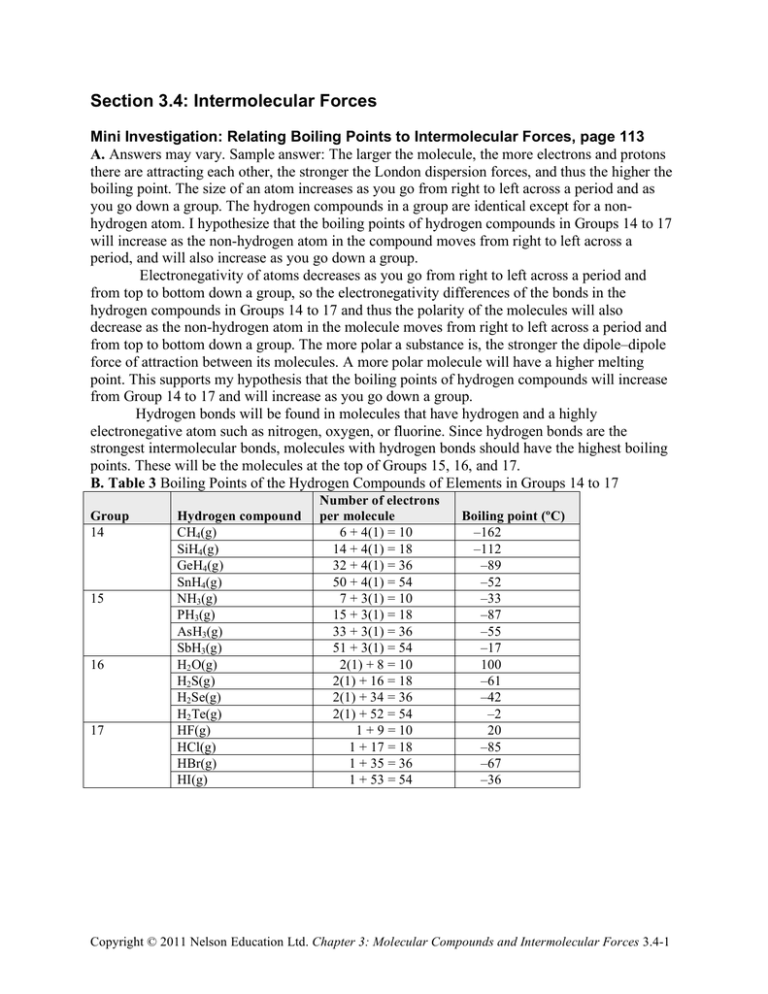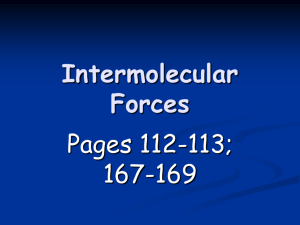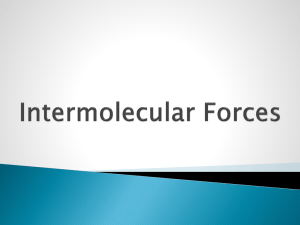Section 3.4: Intermolecular Forces
advertisement

Section 3.4: Intermolecular Forces Mini Investigation: Relating Boiling Points to Intermolecular Forces, page 113 A. Answers may vary. Sample answer: The larger the molecule, the more electrons and protons there are attracting each other, the stronger the London dispersion forces, and thus the higher the boiling point. The size of an atom increases as you go from right to left across a period and as you go down a group. The hydrogen compounds in a group are identical except for a nonhydrogen atom. I hypothesize that the boiling points of hydrogen compounds in Groups 14 to 17 will increase as the non-hydrogen atom in the compound moves from right to left across a period, and will also increase as you go down a group. Electronegativity of atoms decreases as you go from right to left across a period and from top to bottom down a group, so the electronegativity differences of the bonds in the hydrogen compounds in Groups 14 to 17 and thus the polarity of the molecules will also decrease as the non-hydrogen atom in the molecule moves from right to left across a period and from top to bottom down a group. The more polar a substance is, the stronger the dipole–dipole force of attraction between its molecules. A more polar molecule will have a higher melting point. This supports my hypothesis that the boiling points of hydrogen compounds will increase from Group 14 to 17 and will increase as you go down a group. Hydrogen bonds will be found in molecules that have hydrogen and a highly electronegative atom such as nitrogen, oxygen, or fluorine. Since hydrogen bonds are the strongest intermolecular bonds, molecules with hydrogen bonds should have the highest boiling points. These will be the molecules at the top of Groups 15, 16, and 17. B. Table 3 Boiling Points of the Hydrogen Compounds of Elements in Groups 14 to 17 Group 14 15 16 17 Hydrogen compound CH4(g) SiH4(g) GeH4(g) SnH4(g) NH3(g) PH3(g) AsH3(g) SbH3(g) H2 O(g) H2S(g) H2Se(g) H2 Te(g) HF(g) HCl(g) HBr(g) HI(g) Number of electrons per molecule 6 + 4(1) = 10 14 + 4(1) = 18 32 + 4(1) = 36 50 + 4(1) = 54 7 + 3(1) = 10 15 + 3(1) = 18 33 + 3(1) = 36 51 + 3(1) = 54 2(1) + 8 = 10 2(1) + 16 = 18 2(1) + 34 = 36 2(1) + 52 = 54 1 + 9 = 10 1 + 17 = 18 1 + 35 = 36 1 + 53 = 54 Boiling point (ºC) –162 –112 –89 –52 –33 –87 –55 –17 100 –61 –42 –2 20 –85 –67 –36 Copyright © 2011 Nelson Education Ltd. Chapter 3: Molecular Compounds and Intermolecular Forces 3.4-1 C. D. In the hydrogen compounds of elements in Groups 14 to 17, the boiling points increase from Group 14 to 16, but then drop again in Group 17. The trend within the groups is for the boiling point to increase with the number of electrons per molecule. This is the case except for the hydrogen compounds in Period 2, which have exceptionally high boiling points, and for CH4, which has the lowest boiling point of all. E. Answers will vary. Sample answer: My hypothesis and the concept of intermolecular forces used in my explanation are generally correct. For the most part, the boiling points increase with the size of the molecule as you move from Group 14 to 17 and as you go down a group. In general, the polar molecules (Groups 15 to 17) have higher boiling points than the non-polar molecules (Group 14). The compounds that contain hydrogen bonds, NH3, H2O, and HF, have the highest boiling points. F. The anomalies in the evidence presented are the very high boiling points of ammonia, NH3, water, H2O, and hydrogen fluoride, HF, explained by their hydrogen bonds. Another anomaly is that the Group 17 hydrogen compounds have lower boiling points than the Group 16 compounds. To fit the boiling points trends best, Group 17 compounds would be placed between the Group 14 and 15 compounds. This anomaly may be due to the different shapes of the molecules in each group. Also, SnH4, although non-polar, has a higher boiling point than some of the smaller polar molecules. This suggests that the number of electrons in a molecule has a stronger influence on the boiling point than the polarity—a very large non-polar molecule may have a higher boiling point than a small polar molecule. Section 3.4 Questions, page 115 1. (a) The type intermolecular force illustrated is hydrogen bonding. (b) The type of intermolecular force illustrated is dipole–dipole force. 2. The three types of intermolecular forces in order of increasing strength are London dispersion forces, dipole–dipole forces, and hydrogen bonds. 3. The relative strengths of the bonds and forces are London dispersion forces < dipole–dipole forces < hydrogen bonds < covalent bonds. 4. Intermolecular forces that exist between molecules: (a) Oxygen gas, O2(g): London dispersion forces (b) Dichlorine monoxide, Cl2O(g): London dispersion forces, dipole–dipole forces (c) Water, H2O(l): London dispersion forces, hydrogen bonds (d) Methane, CH4(g): London dispersion forces (e) Chloromethane, CH3Cl(g): London dispersion forces, dipole–dipole forces Copyright © 2011 Nelson Education Ltd. Chapter 3: Molecular Compounds and Intermolecular Forces 3.4-2 5. To order the substances by melting point, first determine the molecular polarity: H2O is polar (oxygen and 2 other atoms of the same element). CH4 is non-polar (carbon and 4 atoms of the same element). CH3Cl is polar (carbon and other atoms of 2 or more elements). NH3 is polar (nitrogen and 3 other atoms of the same element). CH3OH is polar (carbon and other atoms of 2 or more elements). H2 is non-polar (diatomic with 2 identical atoms). C3H8 is non-polar (carbon and 2 or more atoms of the same element). The non-polar compounds will have only London forces and likely the lowest melting points. Look at the number of electrons in each molecule: H2 has 2(1) = 2 electrons. CH4 has 1(6) + 4(1) = 10 electrons. C3H8 has 3(6) + 8(1) = 26 electrons. The polar compounds are H2O, NH3, CH3OH, and CH3Cl. The electronegativity differences are 1.2 for H–O, 0.8 for N–H, 0.6 for C–Cl, and 0.4 for C–H. H2O and NH3 will be the most polar molecules. Water molecules can form four hydrogen bonds each, whereas ammonia can only form one hydrogen bond per molecule, so water will have a stronger structure and a higher melting point: NH3 < H2O The C–H bonds in CH3OH and CH3Cl are not significantly polar. CH3Cl is the larger molecule of the two and will have fairly strong London forces but it does not have a hydrogen bond like CH3OH, so CH3OH should have a higher melting point. CH3Cl < CH3OH < NH3 < H2O Hence the melting points from lowest to highest are: H2 < CH4 < C3H8 < CH3Cl < NH3 < CH3OH < H2O 6. Molecular compounds will most likely have stronger odours because their intermolecular forces are generally weaker than the ionic bonds in an ionic substance. With weaker intermolecular forces, the molecules are able to “escape” more easily into a gas state. 7. (a) Water has a considerably higher boiling point than methane, CH4(g), because of the strong hydrogen bonds between water molecules. Methane molecules only have the relatively weak London dispersion forces between them. (b) Bromine is a liquid at ordinary temperatures whereas chlorine is a gas because the London dispersion forces between Br2 molecules are stronger than the London dispersion forces between Cl2 molecules. This is because as the size of the molecule increases there are more electrons and protons attracting each other. (c) Trichloromethane, CHCl3, has a higher boiling point than tetrachloromethane, CCl4, because trichloromethane is polar, with dipole–dipole forces between the molecules, whereas tetrachloromethane is non-polar with only the relatively weaker London dispersion forces between the molecules. 8. Answers may vary. Sample answer: The Bose–Einstein condensate is a state of matter that is much less energetic than the solid state. At zero degrees Kelvin, absolute zero, all molecular motion stops. At just a few billionths of a degree above absolute zero, atoms reach the state of Bose–Einstein condensation. In a Bose–Einstein condensate, intermolecular forces no longer apply. Atoms lose their individual identities and all take on the same attributes. They clump together, all in the same place, and become a single “super atom.” Scientists Satyendra Bose and Albert Einstein predicted the possibility of the Bose–Einstein condensate in the 1920s, but they Copyright © 2011 Nelson Education Ltd. Chapter 3: Molecular Compounds and Intermolecular Forces 3.4-3 did not have the equipment needed to make it happen. In 1995, two American scientists, Eric Cornell and Carl Wieman, finally created this new state of matter. 9. (a) Answers may vary. Sample answer: Some examples of viscous substances are molasses, maple syrup, ketchup, motor oil, and paint. (b) Viscosity is a useful property because viscous or non-viscous materials can be used for specific functions, including lubricants and hydraulics. (c) Answers may vary depending on choices of viscous substances in part (a). Sample answer: All molecules would have London forces. Sugars such as molasses and maple syrup contain hydrogen bonds. Ketchup contains sugars, so it would also contain hydrogen bonds. Motor oils and paint are hydrocarbons, which are often very large molecules with strong London forces. (d) In general, the viscosity of a liquid is largely determined by the strength of its intermolecular forces. When that force is great, the resistance of the liquid to flow (its viscosity) will be great as well. A substance with smaller molecules will have weaker London forces and thus will flow more rapidly. However, if a molecule has hydrogen bonds, even if it is smaller than another molecule, the substance will be more viscous due to the hydrogen bonding, which is a much stronger intermolecular attraction than London forces. Copyright © 2011 Nelson Education Ltd. Chapter 3: Molecular Compounds and Intermolecular Forces 3.4-4







